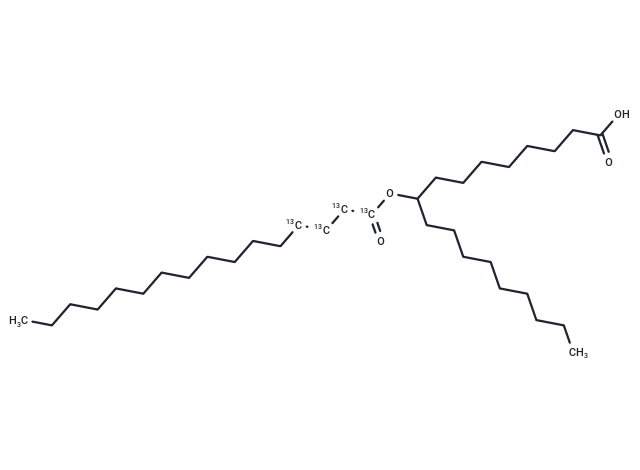- Remove All
 Your shopping cart is currently empty
Your shopping cart is currently empty
9-PAHSA 13C4
Branched fatty acid esters of hydroxy fatty acids (FAHFAs) are a class of endogenous lipids whose levels are modulated by fasting and high-fat diets, and they play a role in insulin sensitivity. These compounds consist of a fatty acid—either a C-16 or C-18, such as palmitoleic, palmitic, oleic, or stearic acid—esterified to a hydroxylated C-16 or C-18 lipid. One notable FAHFA, 9-PAHSA, features an ester linkage between palmitic acid and 9-hydroxy stearic acid. PAHSAs, with 9-PAHSA being the most prevalent isomer, are significantly found in the serum and both white and brown adipose tissues of glucose-tolerant AG4OX mice, which express the Glut4 gene in adipose tissue, enhancing insulin sensitivity. Additionally, 9-PAHSA is abundant in wild type and AG4OX mice and present in humans, though at reduced levels in those with insulin resistance. 9-PAHSA is associated with improved glucose tolerance, enhanced insulin secretion, and anti-inflammatory effects in mice. The compound 19-PAHSA^13C4 represents an isotopically enriched form of this polyunsaturated fatty acid.

9-PAHSA 13C4
| Pack Size | Price | Availability | Quantity |
|---|---|---|---|
| 10 mg | Inquiry | 8-10 weeks | |
| 50 mg | Inquiry | 8-10 weeks |
Product Introduction
| Description | Branched fatty acid esters of hydroxy fatty acids (FAHFAs) are a class of endogenous lipids whose levels are modulated by fasting and high-fat diets, and they play a role in insulin sensitivity. These compounds consist of a fatty acid—either a C-16 or C-18, such as palmitoleic, palmitic, oleic, or stearic acid—esterified to a hydroxylated C-16 or C-18 lipid. One notable FAHFA, 9-PAHSA, features an ester linkage between palmitic acid and 9-hydroxy stearic acid. PAHSAs, with 9-PAHSA being the most prevalent isomer, are significantly found in the serum and both white and brown adipose tissues of glucose-tolerant AG4OX mice, which express the Glut4 gene in adipose tissue, enhancing insulin sensitivity. Additionally, 9-PAHSA is abundant in wild type and AG4OX mice and present in humans, though at reduced levels in those with insulin resistance. 9-PAHSA is associated with improved glucose tolerance, enhanced insulin secretion, and anti-inflammatory effects in mice. The compound 19-PAHSA^13C4 represents an isotopically enriched form of this polyunsaturated fatty acid. |
| Molecular Weight | 542.9 |
| Formula | C30[13C]4H66O4 |
| Cas No. | 2748638-71-1 |
| Storage | Powder: -20°C for 3 years | In solvent: -80°C for 1 year | Shipping with blue ice. |
Calculator
In Vivo Formulation Calculator (Clear solution)
Dose Conversion
Tech Support

Copyright © 2015-2025 TargetMol Chemicals Inc. All Rights Reserved.




